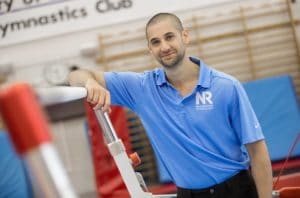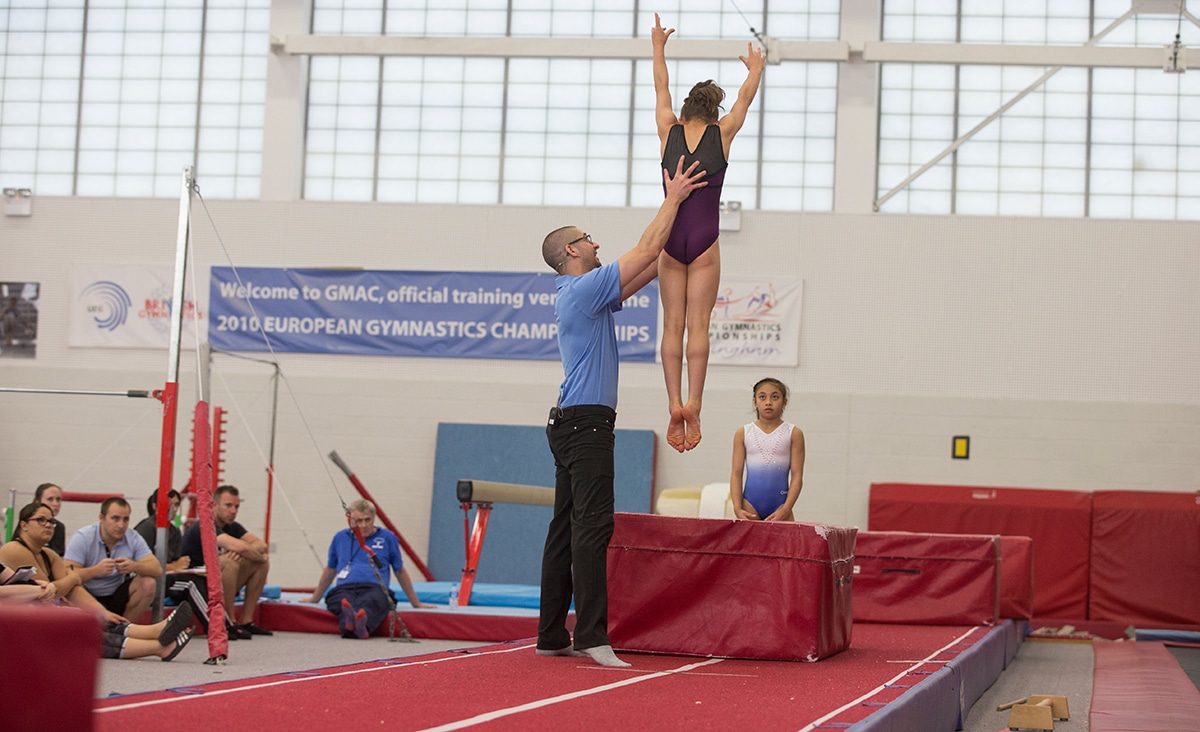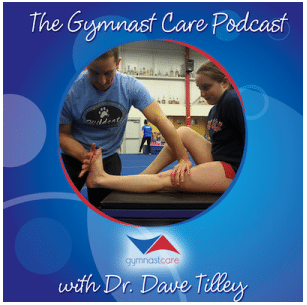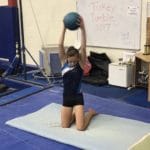Physical Preperation Must Haves for Gymnasts – A “10 Quick Tips” Guest Post by Nick Ruddock
Today, I’m excited to bring you Part 2 of the guest post series from my good friend Nick Ruddock. In his last guest post, Nick went over some fantastic points about preventing a toxic gymnastics training culture, and instead turning it into a world-class training environment. If you missed that blog post be sure to check it out here.
I asked Nick to write another blog post on one of his specialties, which is Physical Preparation. Many people in the gymnastics world know this as strength, flexibility, and cardio, but in reality, there is so much more that goes into it. Nick and I have spent an insane amount of time talking about this topic, and really share core philosophies for Physical Preparation. Without further wait, here he is again.
This is my second ‘Top Tips’ blog for Dave, following my previous article on advice to improve gym cultures. I spend a significant portion of my time with all my clients (from club level through to national federations) talking about the implications and impact that physical preparation plays on technical performance.
Dave is a great influencer on this topic, and someone who I am extremely aligned with regards to a vision of protecting an athletes future through a carefully constructed physical preparation programme.
Here are ten tips for coaches based on my experience to date consulting for 14 International Federations, plus personal and national coaching responsibilities:
- Be Proactive
Smart coaches adopt a proactive approach to physical preparation to ensure that their athletes are not only mitigating risk of injuries, but also ahead of their technical abilities. The athletes level of physical robustness must exceed that which is required for technical performance. If the balance is tipped in favor of technical competency, the athlete will almost always get injured. It’s just a case of ‘when’. Most ‘limiting factors’ or physical deficiencies can be identified very early, I refer to these potential problems as ‘red flags.’ Dave has a bunch of blogs and videos referring to useful screening exercises that can help to identify these. More often than not, they are common sense. But common sense isn’t always common practice …
- Don’t Wait
Once you’ve identified a physical deficiency, or opportunity to improve performance through better physical preparation, act on it! Don’t sit on your hands and wait for an appropriate time. Here’s the reality; there is never an appropriate time to adjust training. There is always a competition/meet around the corner, always a change in training phases, or a time where the athlete really needs to be working on new skill development. A quote that springs to mind; ‘if you had just started running a marathon and you had a stone in your shoe, when would you take it out?’
- Collaborate
Coaches have a habit of spinning plates, managing numerous roles and responsibilities. We can also be guilty of wanting to maintain a sense of control over programming. The reality is, there are a ton of physical preparation specialists who are far better qualified than the majority of us to prescribe certain aspects of physical preparation ( prehab/ rehab/strength and conditioning/movement competency etc.) Collaborating with external specialists (or even better bringing them in-house!) is a great way to leverage others’ expertise, and ensure your programmes are optimised for the athletes. Stuck on screening and identifying red flags? Contact your local universities and colleges to see if they have any exercise physiology students who could do with some hands-on experience. They’ll help put together a great screening programming which you can implement for your team.
- Avoid ‘fluffy’ programming
‘Fluff’ is the stuff that doesn’t make a difference. It doesn’t matter if it’s in or out, your athlete won’t suffer or improve either way. Fluff takes time. Get rid of it. Focus on fundamentals first and the exercises that really are critical to improving performance. Fluffy ideas and exercises are becoming more and more of an issue now as coaches spend so much time on YouTube and Facebook seeing exercises which look great to the eye, but are not relevant or required for your athlete. That’s a significant portion of what many coaches do.
- Have a structure
One of my first tasks when taking on a new client or visiting a club to assist with programming is to look at their physical preparation structure. I’m looking at the frequency, total volume, organization and allocation of time etc. Many clubs don’t have anything more than a piece of paper that says ‘Monday, conditioning 30mins.’ The time will then be filled with whatever ideas pop into the head when that slot comes about (flavor of the month!) Having a structure will not only ensure that all the different components are included but helps to monitor load and aspects of the program which simply aren’t working.
(To help structure your athletes’ conditioning programming, I have a great free coaching template available at www.nickruddock.com/daily-dozen)
- Supervise
Physical preparation, in many cases is safer to leave unsupervised in comparison to technical performance, but you’d be foolish to do so. When you allow your athlete to perform their physical preparation alone (particular emphasis on developmental athletes) you are sending them the message that it is less important to you, as a coach than the technical performance. Not to mention the obvious concerns about not being around to regulate and reinforce technique and accuracy of performance. Make sure your schedule allows you to be with the athletes.
- Prioritise the Time
You’ll never fit everything into your programme, so don’t try. First, identify what is the most important. You can do that by asking the question ‘what exercises or components of a physical preparation programme will give my athletes the most performance gains?’ If you always prioritize the things that move the needle the most, you’ll start to devalue and not use the ‘fluffy’ content which I spoke about in point 4.
- Listen to your athlete
Take the guesswork out of your programming and ask your athlete how their body feels, what feels weak, where they are sore etc. You’ll be amazed what you can learn by doing this. Plus it will help the athlete-coach relationship.
- Ensure Volume and Frequency is adequate
Frequency is more important than total volume, BUT there is a threshold that you must reach with your total volume of physical preparation. I advise somewhere between 25-33% of your total training volume to be spent on physical preparation related activities. It doesn’t matter if your athlete is training 10 or 30 hours a week, the ratio remains the same. Frequency (how often you are doing the physical preparation) is critical also. I’d rather see an athlete spend 40 mins on physical preparation per day, rather than cramming the same total weekly volume into just two days.
- Don’t neglect the significance of the time
Volume is one thing, but it’s the actual workload achieved at that time which is most crucial. I’ve seen some clubs spend 2 hours doing what another club could achieve in 30 mins. It is of course as a result of the work ethic and efficiency of the team. 10 hours physical preparation on your schedule may tick many boxes, but it’s failing to deliver the intended results if you’re only accomplishing on an hour of work.
Thanks for reading, and I hope this content is useful to you. As we enter a New Year, now is the ideal time to reflect on where you program is at, and the changes you may need to make in order to get to where you want to be. ‘If nothing changes then nothing changes.’
Nick
About Nick

“Nick Ruddock contributed to historic medal-winning performances on the international stage throughout his four-year term with British Gymnastics as National Coach. Nick represented Great Britain and Team GB on numerous occasions throughout his national coaching role, culminating with the 2014 Junior European Championships, where the British girls captured a historic six-medal haul including a record Team Silver ahead of European superpower Romania.
Nick, a former personal coach to Amy Tinkler; European, World and Olympic Medallist, has been mentored by some of the world’s most experienced and accomplished coaches throughout several influential countries.
Nick has lectured as a Technical Expert for the UEG (Union of European Gymnastics) for 7 years, and has consulted for over a dozen international gymnastics federations and a variety of performance sports, with a mission of optimizing athlete and coach performance for the world stage.
For more information on Nick’s services, including online courses, conferences, events and coaching programmes, visit www.nickruddock.com”









